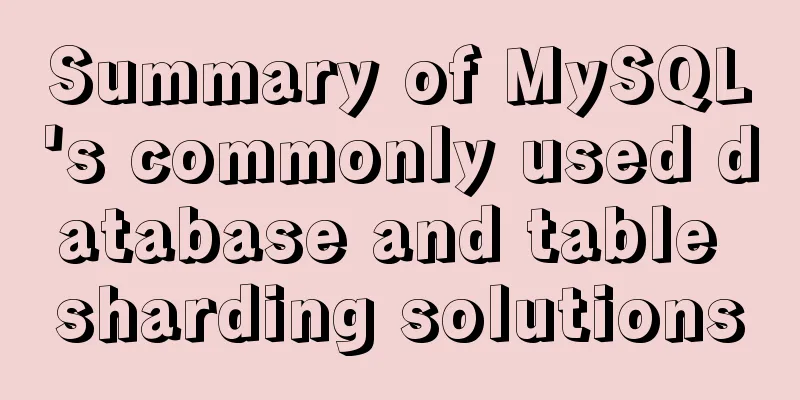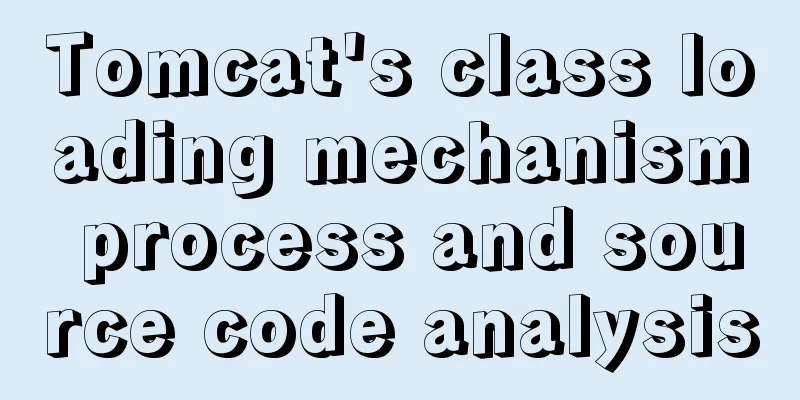Summary of MySQL's commonly used database and table sharding solutions

1. Database bottleneckWhether it is an IO bottleneck or a CPU bottleneck, it will eventually lead to an increase in the number of active connections of the database, and then approach or even reach the threshold of the number of active connections that the database can carry. From the perspective of business services, there are few or even no available database connections. You can imagine what will happen next (concurrency, throughput, and crashes). 1. IO bottleneck The first type: Disk read IO bottleneck. There is too much hot data and the database cache cannot store it. Each query will generate a large amount of IO, which reduces the query speed -> sharding and vertical sharding. The second type: Network IO bottleneck, too much data is requested, and the network bandwidth is insufficient -> sharding. 2. CPU bottleneck The first type: SQL problems, such as SQL containing join, group by, order by, non-index field conditional query, etc., which increase CPU computing operations -> SQL optimization, establish appropriate indexes, and perform business calculations at the business service layer. The second type: The amount of data in a single table is too large, too many rows are scanned during query, SQL efficiency is low, and the CPU is the first bottleneck -> Horizontal table partitioning. 2. Sub-library and sub-table1. Horizontal database
Concept: Split the data in one database into multiple databases based on fields and certain strategies (hash, range, etc.). result:
Scenario: The absolute concurrency of the system has increased, and table sharding is difficult to fundamentally solve the problem. In addition, there is no clear business affiliation to vertically shard the database. Analysis: With more libraries, the pressure on IO and CPU can be relieved exponentially. 2. Horizontal table
Concept: Split the data in one table into multiple tables based on fields and according to certain strategies (hash, range, etc.). result:
Scenario: The absolute concurrency of the system has not increased, but the amount of data in a single table is too large, which affects the SQL efficiency and increases the CPU burden, thus becoming a bottleneck. Recommended: An analysis of the principles of SQL query optimization Analysis: The amount of data in the table is reduced, and the efficiency of single SQL execution is high, which naturally reduces the burden on the CPU. 3. Vertical sub-database
Concept: Based on the table, different tables are divided into different databases according to different business attributes. result:
Scenario: The absolute concurrency of the system has increased, and separate business modules can be abstracted. Analysis: At this point, it can basically be turned into a service. For example, as the business develops, there are more and more public configuration tables and dictionary tables. At this time, these tables can be separated into separate libraries or even turned into services. Furthermore, as the business develops and a set of business models are developed, the related tables can be separated into separate databases or even turned into services. 4. Vertical table
Concept: Based on the fields and according to the activity of the fields, the fields in the table are divided into different tables (main table and extended table). result:
Scenario: The absolute concurrency of the system has not increased. The table does not have many records, but has many fields. Hot data and non-hot data are stored together, so the storage space required for a single row of data is large. As a result, the number of data rows in the database cache is reduced, and a large amount of random read IO will be generated when reading disk data during queries, causing an IO bottleneck. Analysis: You can use list pages and detail pages to help you understand. The principle of vertical table splitting is to put hot data (data that may be redundant and often queried together) together as the main table, and put non-hot data together as the extended table. In this way, more hot data can be cached, thereby reducing random read IO. After the split, if you want to get all the data, you need to join two tables to get the data. But remember, never use join, because join will not only increase the CPU burden but also couple the two tables together (must be on one database instance). For associated data, you should work on the business service layer, get the main table and extended table data separately, and then use the associated fields to associate to get all the data. 3. Library and table sharding tools
4. Steps for splitting databases and tablesEvaluate the number of shards or tables based on capacity (current capacity and growth) -> select key (evenly) -> table sharding rules (hash or range, etc.) -> execute (generally double write) -> capacity expansion issues (minimize data movement). 5. Issues with sharding1. Non-partition key query problemBased on horizontal database and table sharding, the splitting strategy is the commonly used hash method. In addition to the partition key, there is only one non-partition key on the client as a condition for query Mapping method
Genetic method
In addition to the partition key, there is more than one non-partition key as a condition for query on the client Mapping method
Redundancy method
In addition to the partition key, the background also has various non-partition key combination condition queries NoSQL approach
Redundancy method
2. Non-partition key cross-database and cross-table paging query problemBased on horizontal database and table sharding, the splitting strategy is the commonly used hash method.
3. Capacity expansion issuesBased on horizontal database and table sharding, the splitting strategy is the commonly used hash method. Horizontal expansion of the database (upgrade from the database method)
Horizontal expansion table (double write migration method)
Step 1: (Synchronous dual writing) Modify the application configuration and code, add dual writing, and deploy; Step 2: (Synchronous Dual Write) Copy the old data in the old database to the new database; Step 3: (Synchronous dual writing) Verify the old data in the new database based on the old database; Step 4: (Synchronous double writing) Modify the application configuration and code, remove the double writing, and deploy;
6. Summary of Sub-library and Sub-tableTo split the database and tables, you must first know where the bottleneck is, and then you can split it reasonably (split the database or split the table? Horizontally or vertically? How many times?). And it cannot be split for the purpose of dividing the database and table. Choosing the key is very important. It is necessary to consider both even splitting and non-partition key queries. As long as the requirements are met, the splitting rules should be as simple as possible. This concludes this article on the summary of commonly used MySQL sharding solutions. For more information about MySQL sharding, please search for previous articles on 123WORDPRESS.COM or continue to browse the following related articles. I hope you will support 123WORDPRESS.COM in the future! You may also be interested in:
|
<<: Using JS to implement a rotating Christmas tree in HTML
>>: A simple way to clear the CSS, JavaScript and background image cache in the browser
Recommend
MySQL Binlog Data Recovery: Detailed Explanation of Accidentally Deleting a Database
MySQL Bin log data recovery: accidentally delete ...
Summary of knowledge points related to null (IFNULL, COALESCE and NULLIF) in MySQL
This article uses examples to explain the knowled...
Solution to large line spacing (5 pixels more in IE)
Copy code The code is as follows: li {width:300px...
Detailed explanation of how to use the Vue date time picker component
This article example shares the specific code of ...
How to use the Clipboard API in JS
Table of contents 1. Document.execCommand() metho...
Detailed explanation of MySQL startup options and system variables examples
Table of contents Boot Options Command Line Long ...
Learn MySQL database in one hour (Zhang Guo)
Table of contents 1. Database Overview 1.1 Develo...
Docker intranet builds DNS and uses domain name access instead of ip:port operation
For example, if I have a Jenkins server in my int...
Vue uses OSS to upload pictures or attachments
Use OSS to upload pictures or attachments in vue ...
Detailed explanation of the basic usage of the Linux debugger GDB
Table of contents 1. Overview 2. gdb debugging 2....
Vue custom v-has instruction, steps for button permission judgment
Table of contents Application Scenario Simply put...
Encapsulate the navigation bar component with Vue
Preface: Fully encapsulating a functional module ...
An article to master MySQL index query optimization skills
Preface This article summarizes some common MySQL...
Docker custom network container interconnection
Table of contents Preface –link Custom Network As...
Nginx configuration location matching rules example explanation
The scope of nginx configuration instructions can...





















